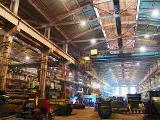Classification of premises in terms of electrical safety
 Measures to ensure electrical safety depend on the purpose of the room in which the electrical installation is located and on the nature of the room. By arrangement, there are specialized rooms with electrical installations and rooms for other purposes (production, domestic, office, commercial, etc.).
Measures to ensure electrical safety depend on the purpose of the room in which the electrical installation is located and on the nature of the room. By arrangement, there are specialized rooms with electrical installations and rooms for other purposes (production, domestic, office, commercial, etc.).
Outdoor air conditions and other environmental factors can increase or decrease the risk of electric shock to people. For example, moisture, conductive dust, corrosive vapors and gases, heat have a destructive effect on the insulation of electrical equipment, which leads to a decrease in the resistance of the human body.
The risk of electric shock also increases in the presence of conductive floors and metal grounded objects located near electrical equipment, contributing to the creation of an electrical circuit through the human body.
According to the degree of danger of electric shock to people, all premises of electrical installations, according to PUE, is divided into three classes: without increased danger, with increased danger and especially dangerous.
Premises with electrical installations — these are such premises or enclosed parts of the premises in which the controlled electrical equipment is installed and which are accessible only to personnel with the necessary qualifications and approval for maintenance of electrical installations.
Rooms with electrical installations are usually characterized by conditions that differ from normal, high temperature, humidity and a large amount of metal equipment connected to earth. All this creates an increased risk of electric shock. V Rules for electrical installation the following classification of premises is given: dry, damp, damp, especially damp, hot and dusty.
Dry rooms are called rooms in which the relative humidity does not exceed 60%.
Wet rooms are called rooms in which vapors and condensing moisture are released only for a short time in small quantities, and the relative humidity of the air is more than 60%, but does not exceed 75%.
Wet rooms are called rooms in which the relative humidity of the air exceeds 75% for a long time.
Particularly humid rooms are called rooms in which the relative humidity of the air is close to 100% (ceilings, walls, floors and objects in the room are covered with moisture).
Hot rooms are called rooms in which, under the influence of various heat radiations, the temperature constantly or periodically (more than one day) exceeds 35 ° C.
Dust rooms are called rooms in which, according to the production conditions, technological dust is released in such an amount that it can settle on wires, penetrate into machines, devices, etc.Dust rooms are divided into rooms with conductive dust and rooms with non-conductive dust. In addition, a distinction is made between rooms with a chemically active or organic environment, where aggressive vapors, gases, liquids continuously or for a long time form deposits or mold, destroying the insulation and live parts of electrical equipment.
Given these signs, the premises are divided into three groups according to the degree of danger of electric shock.
Premises without increased danger in which there are no conditions that create increased or special danger.
An example of such premises can be residential premises, offices, laboratories, some industrial premises (assembly workshops of watch and tool factories).
Premises with increased danger, which are characterized by the presence in them of one of the following conditions that create increased danger: moisture or conductive dust, conductive floors (metal, earth, reinforced concrete, bricks, etc.), high temperature, possibility of simultaneous contact of a person to metal structures connected to ground buildings, technological devices, mechanisms, on the one hand, and to metal casings of electrical equipment, on the other hand.
For example, such premises can be stairwells of various buildings with transport hubs, various workshop premises, mill premises, hot workshops, workshops with electrified machines, where there is always the possibility of simultaneously touching the engine casing and the machine, etc.
Particularly dangerous premises, which are characterized by the presence of one of the following conditions that create a special danger: special moisture, chemically active or organic environment, two or more conditions of increased danger at the same time.
An example of such a room is a large part of industrial premises, including all shops of machine-building and metallurgical plants, power plants and chemical plants, electroplating shops, etc.
With regard to the danger of electric shock, the territory of the location of external electrical installations is equated to particularly dangerous premises.
